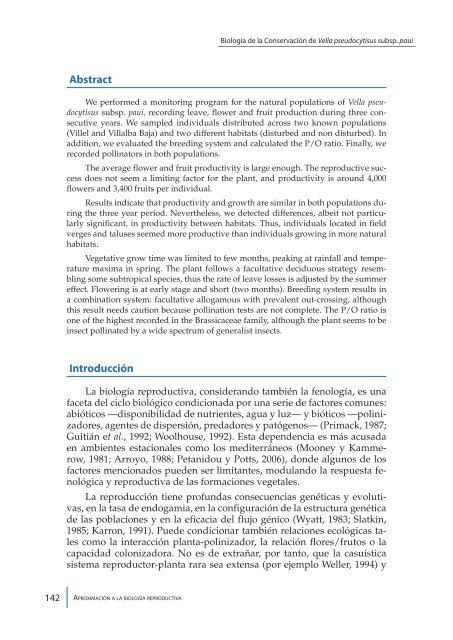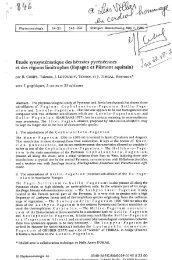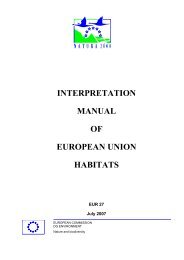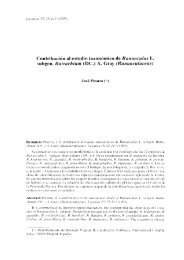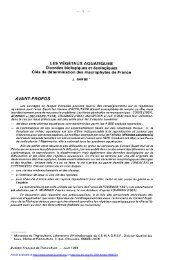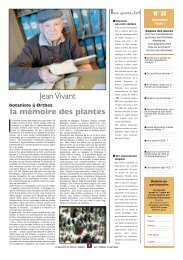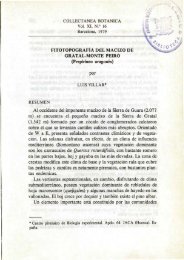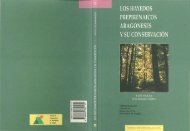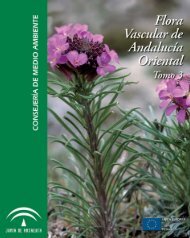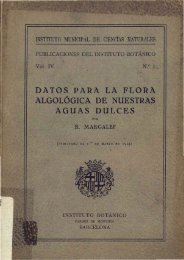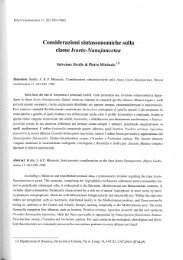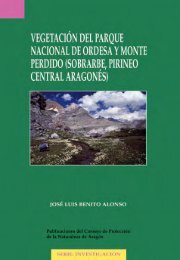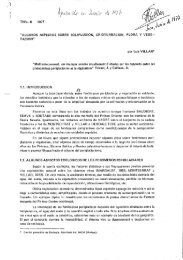Biología de la Conservación de Vella pseudocytisus subespecie ...
Biología de la Conservación de Vella pseudocytisus subespecie ...
Biología de la Conservación de Vella pseudocytisus subespecie ...
You also want an ePaper? Increase the reach of your titles
YUMPU automatically turns print PDFs into web optimized ePapers that Google loves.
Abstract<br />
142 aProxImacIón a <strong>la</strong> bIología reProductIva<br />
<strong>Biología</strong> <strong>de</strong> <strong>la</strong> <strong>Conservación</strong> <strong>de</strong> Vel<strong>la</strong> <strong>pseudocytisus</strong> subsp. paui<br />
We performed a monitoring program for the natural popu<strong>la</strong>tions of Vel<strong>la</strong> <strong>pseudocytisus</strong><br />
subsp. paui, recording leave, flower and fruit production during three consecutive<br />
years. We sampled individuals distributed across two known popu<strong>la</strong>tions<br />
(villel and vil<strong>la</strong>lba Baja) and two different habitats (disturbed and non disturbed). in<br />
addition, we evaluated the breeding system and calcu<strong>la</strong>ted the p/o ratio. Finally, we<br />
recor<strong>de</strong>d pollinators in both popu<strong>la</strong>tions.<br />
the average flower and fruit productivity is <strong>la</strong>rge enough. the reproductive success<br />
does not seem a limiting factor for the p<strong>la</strong>nt, and productivity is around 4,000<br />
flowers and 3,400 fruits per individual.<br />
results indicate that productivity and growth are simi<strong>la</strong>r in both popu<strong>la</strong>tions during<br />
the three year period. nevertheless, we <strong>de</strong>tected differences, albeit not particu<strong>la</strong>rly<br />
significant, in productivity between habitats. thus, individuals located in field<br />
verges and taluses seemed more productive than individuals growing in more natural<br />
habitats.<br />
vegetative grow time was limited to few months, peaking at rainfall and temperature<br />
maxima in spring. the p<strong>la</strong>nt follows a facultative <strong>de</strong>ciduous strategy resembling<br />
some subtropical species, thus the rate of leave losses is adjusted by the summer<br />
effect. Flowering is at early stage and short (two months). Breeding system results in<br />
a combination system: facultative allogamous with prevalent out-crossing, although<br />
this result needs caution because pollination tests are not complete. the p/o ratio is<br />
one of the highest recor<strong>de</strong>d in the Brassicaceae family, although the p<strong>la</strong>nt seems to be<br />
insect pollinated by a wi<strong>de</strong> spectrum of generalist insects.<br />
Introducción<br />
<strong>la</strong> biología reproductiva, consi<strong>de</strong>rando también <strong>la</strong> fenología, es una<br />
faceta <strong>de</strong>l ciclo biológico condicionada por una serie <strong>de</strong> factores comunes:<br />
abióticos —disponibilidad <strong>de</strong> nutrientes, agua y luz— y bióticos —polinizadores,<br />
agentes <strong>de</strong> dispersión, predadores y patógenos— (primack, 1987;<br />
guitián et al., 1992; Woolhouse, 1992). esta <strong>de</strong>pen<strong>de</strong>ncia es más acusada<br />
en ambientes estacionales como los mediterráneos (mooney y Kammerow,<br />
1981; arroyo, 1988; petanidou y potts, 2006), don<strong>de</strong> algunos <strong>de</strong> los<br />
factores mencionados pue<strong>de</strong>n ser limitantes, modu<strong>la</strong>ndo <strong>la</strong> respuesta fenológica<br />
y reproductiva <strong>de</strong> <strong>la</strong>s formaciones vegetales.<br />
<strong>la</strong> reproducción tiene profundas consecuencias genéticas y evolutivas,<br />
en <strong>la</strong> tasa <strong>de</strong> endogamia, en <strong>la</strong> configuración <strong>de</strong> <strong>la</strong> estructura genética<br />
<strong>de</strong> <strong>la</strong>s pob<strong>la</strong>ciones y en <strong>la</strong> eficacia <strong>de</strong>l flujo génico (Wyatt, 1983; s<strong>la</strong>tkin,<br />
1985; Karron, 1991). pue<strong>de</strong> condicionar también re<strong>la</strong>ciones ecológicas tales<br />
como <strong>la</strong> interacción p<strong>la</strong>nta-polinizador, <strong>la</strong> re<strong>la</strong>ción flores/frutos o <strong>la</strong><br />
capacidad colonizadora. no es <strong>de</strong> extrañar, por tanto, que <strong>la</strong> casuística<br />
sistema reproductor-p<strong>la</strong>nta rara sea extensa (por ejemplo Weller, 1994) y


